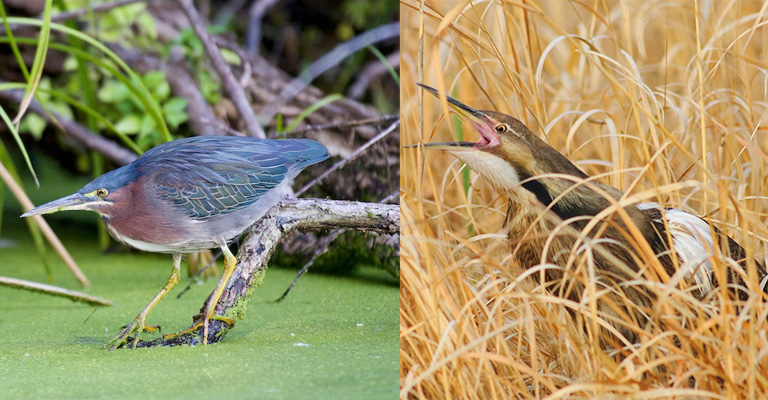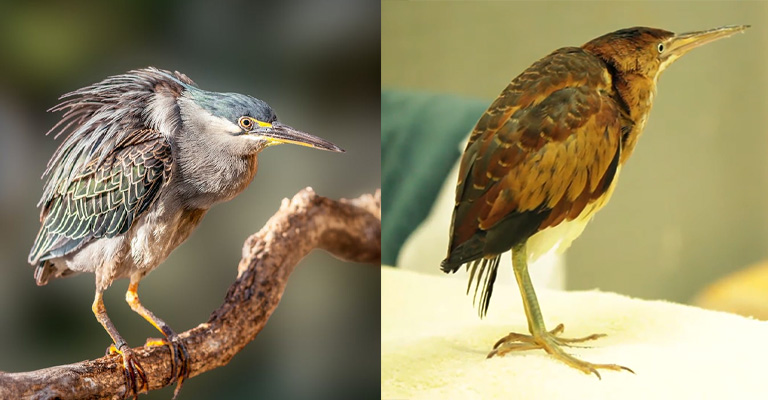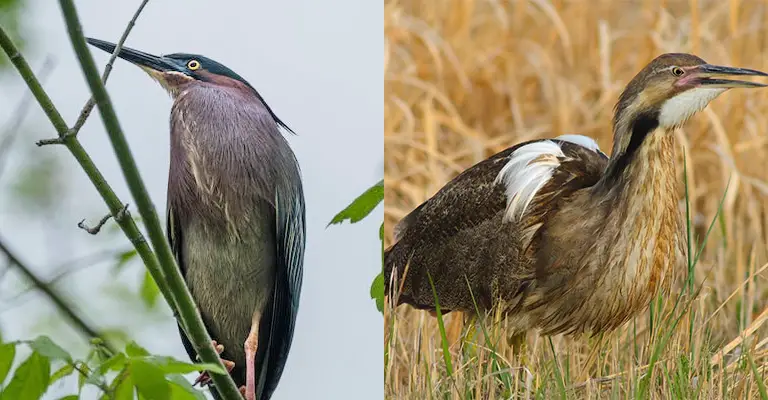Green Herons and Least Bitterns are two fascinating bird species commonly found in wetland habitats across North America. Though they are not the same species, people often find it difficult to identify them specifically.
While they may share similar habitats and exhibit some overlapping characteristics, they are distinct in their appearances, behaviors, and ecological roles. Also, they have a lot of differences in other factors.
In this introduction, we will explore the differences between Green Herons and Least Bitterns, shedding light on their unique features and highlighting the importance of their conservation in maintaining the delicate balance of wetland ecosystems.

Physical Appearance: Green Heron Vs. Least Bittern
The Green Heron (Butorides virescens) is named for its uniform greenish coloration on the back and wings. This plumage gives it a camouflage advantage in its wetland surroundings.
The Least Bittern (Ixobrychus exilis) exhibits straw-colored wings that contrast with a darker back. This coloration creates a distinctive pattern, especially when the wings are folded.
Appearance
Additionally, the Green Heron boasts a chestnut-colored neck, which provides a striking contrast to its overall greenish body. This unique neck coloration is a notable characteristic of the species.
The Least Bittern’s back is darker compared to its wings, helping it blend in with the reeds and grasses of its wetland habitat. Unlike the Green Heron, the Least Bittern possesses a straw-colored neck that blends in more with its overall plumage.
Neck Coloration
One of the key differences between the two species lies in their neck coloration. While the Green Heron displays a rich chestnut-colored neck, the Least Bittern’s neck is straw-colored.
This variation in neck color provides a reliable indicator when distinguishing between the two birds.
Size Comparison
Although the Green Heron and Least Bittern are similar in size, there is a slight difference between them. On average, the Green Heron measures around 16 to 18 inches (41-46 cm) in length, making it slightly larger than the Least Bittern.
The latter typically ranges from 11 to 14 inches (28-36 cm) in length. While the difference may be subtle, comparing the size of these birds can contribute to accurate identification.
By understanding the unique physical characteristics of the Green Heron and Least Bittern, including their coloration and size differences, birdwatchers can enhance their ability to correctly identify these fascinating wading birds in the field.
Behavior and Habitat

Not just in their physical appearances, these two beautiful birds have a lot of differences in their behavior and habitats. Let’s check them out.
Green Heron
The Green Heron is known for its perching behavior, often seen standing or crouching on branches near the water’s edge. It displays remarkable fishing techniques, using its sharp bill and quick reflexes to snatch prey from the water.
The Green Heron is patient and strategic, employing tactics such as using bait or lures to attract fish within striking distance. This bird is an adept hunter and can also consume a variety of aquatic insects, amphibians, and small reptiles.
Its foraging behavior is characterized by a deliberate and calculated approach.
Least Bittern
The Least Bittern, in contrast, is a highly secretive and elusive bird. It prefers to hide within dense vegetation, such as cattails and other marshy plants, where it can blend seamlessly into its surroundings.
Its small size and cryptic plumage allow it to move through the reeds and grasses undetected, making it challenging to spot. The Least Bittern relies on stealth and camouflage to navigate its habitat and locate prey.
It has a remarkable ability to walk on floating vegetation, enabling it to access otherwise inaccessible areas within wetlands.
Preferred Habitats
The Green Heron can be found in a range of wetland habitats, including marshes, swamps, ponds, and riversides. It is adaptable and can tolerate both freshwater and saltwater environments.
Green Herons are often associated with areas that offer suitable perching sites, such as overhanging branches or emergent vegetation near water bodies.
The Least Bittern, on the other hand, has a more specific habitat preference. It favors dense emergent vegetation within freshwater marshes, swamps, and wetlands with tall reeds, cattails, or bulrushes.
These habitats provide ample cover and concealment for the secretive nature of the Least Bittern. They are particularly adept at navigating through dense vegetation, making them well-suited for these types of habitats.
While the Green Heron exhibits perching behavior and actively engages in hunting near water bodies, the Least Bittern relies on its secretive nature and expertise in maneuvering through dense vegetation to find prey.
Identification Challenges

A lot of factors work as challenges to identifying these two different species of birds. Here is a list of identification challenges that you might face in this case.
Variations in Plumage Within Species and Individuals
One of the challenges in identifying Green Herons and Least Bitterns is the natural variation in plumage within their respective species. Individual birds can exhibit slight differences in coloration, which can be influenced by factors such as age, sex, and geographic location.
This variation can lead to confusion, especially when relying solely on one characteristic for identification. It is important to consider multiple features and compare them to the typical traits of each species to ensure accurate identification.
Importance of Considering Multiple Characteristics for Accurate Identification
To overcome the challenges posed by plumage variations, it is crucial to consider multiple characteristics when identifying Green Herons and Least Bitterns.
While coloration is an important factor, other features such as size, shape, behavior, and habitat preferences should also be taken into account.
By examining the overall combination of these characteristics, birdwatchers can obtain a more accurate identification.
For instance, while the Green Heron and Least Bittern may share certain similarities in appearance, their behavior and habitat choices differ significantly.
Observing the bird’s behavior, such as perching on branches or hiding in dense vegetation, can provide valuable clues.
Additionally, noting the specific wetland habitats they inhabit, such as marshes versus dense reed beds, can further aid in identification.
Common Differences: Green Herons Vs. Least Bitterns
| Feature | Green Heron | Least Bittern |
| Wing Color | Uniform greenish | Straw-colored with a darker back |
| Neck Color | Chestnut | Straw-colored |
| Back Color | Greenish | Darker |
| Size | Slightly larger (16-18 inches) | Smaller (11-14 inches) |
| Perching Behavior | Common, seen on branches | Less common, often hidden in vegetation |
| Hunting Technique | Patient fishing, using bait or lures | Stealthy movement, quick strikes |
| Preferred Habitat | Wetlands, marshes, ponds, riversides | Freshwater marshes, dense vegetation |
| Wing Pattern | Uniform color, no distinct pattern | Straw-colored with contrasting dark markings |
| Overall Plumage | Greenish, uniform coloration | Lighter belly, darker back, and wings |
| Facial Markings | Yellow on the face, extending forward from eyes | Dark markings around the eyes |
| Nesting Behavior | Solitary nesters, build platform nests | Solitary nesters, construct nests within dense vegetation |
| Vocalizations | Harsh, squawking calls | Low, hollow “coo-coo” or “quok” sounds |
| Foraging Strategy | Patiently waits for prey near water | Moves stealthily through vegetation to find prey |
| Flight Pattern | Direct and swift | Short, low flights |
| Habitat Adaptability | Adaptable to both freshwater and saltwater habitats | Primarily found in freshwater habitats |
| Wing Shape | Rounded wings | Rounded wings |
| Range | Found in North and Central America | Found in North and South America |
| Migratory Behavior | Some populations are migratory | Generally non-migratory, with some regional movements |
| Conservation Status | Least Concern | Least Concern |
| Population Trends | Stable | Stable |
FAQs
Yes, both Green Herons (Butorides virescens) and Least Bitterns (Ixobrychus exilis) belong to the same family, Ardeidae, which includes herons, egrets, and bitterns.
While hybridization between Green Herons and Least Bitterns is rare, there have been a few documented cases of hybrid individuals, especially in areas where their ranges overlap.
Green Herons have a mixed migratory pattern. Some populations are migratory, particularly in the northern parts of their range, while others are non-migratory.
Least Bitterns are generally non-migratory, with some regional movements in response to changing water levels or habitat conditions.
Yes, both species build nests. Green Herons construct platform nests made of sticks, often in trees or shrubs near water. Least Bitterns also build nests, typically within dense vegetation, using materials such as reeds and cattails.
Green Herons and Least Bitterns have similar average lifespans. In the wild, they can live for about 6 to 15 years. However, some individuals have been known to live longer, reaching up to 20 years or more.
Conclusion
The Green Heron and the Least Bittern are both remarkable bird species that inhabit wetland ecosystems, yet they possess distinct characteristics that set them apart.
The Green Heron showcases vibrant plumage and larger size, while the Least Bittern is known for its cryptic coloration and smaller stature.
Despite their differences, both birds excel in their hunting techniques, utilizing patience, stealth, and precision to capture their prey.
Their ability to adapt to diverse wetland habitats demonstrates the resilience and adaptability of avian species.
However, these are the common differences between Green Heron and Least Bittern. Hopefully, you understand them well. So, tell us how you have identified these two species and when you’ll spot them. Thank you in advance.